#Klamath dams
Text
If you aren't following the news here in the Pacific Northwest, this is a very, very big deal. Our native salmon numbers have been plummeting over the past century and change. First it was due to overfishing by commercial canneries, then the dams went in and slowed the rivers down and blocked the salmons' migratory paths. More recently climate change is warming the water even more than the slower river flows have, and salmon can easily die of overheating in temperatures we would consider comfortable.
Removing the dams will allow the Klamath River and its tributaries to return to their natural states, making them more hospitable to salmon and other native wildlife (the reservoirs created by the dams were full of non-native fish stocked there over the years.) Not only will this help the salmon thrive, but it makes the entire ecosystem in the region more resilient. The nutrients that salmon bring back from their years in the ocean, stored within their flesh and bones, works its way through the surrounding forest and can be traced in plants several miles from the river.
This is also a victory for the Yurok, Karuk, and other indigenous people who have relied on the Klamath for many generations. The salmon aren't just a crucial source of food, but also deeply ingrained in indigenous cultures. It's a small step toward righting one of the many wrongs that indigenous people in the Americas have suffered for centuries.
#salmon#dam removal#fish#animals#wildlife#dams#Klamath River#Klamath dams#restoration ecology#indigenous rights#Yurok Tribe#Karuk Tribe#nature#ecology#environment#conservation#PNW#Pacific Northwest
13K notes
·
View notes
Text
The Klamath River’s salmon population has declined due to myriad factors, but the biggest culprit is believed to be a series of dams built along the river from 1918 to 1962, cutting off fish migration routes.
Now, after decades of Indigenous advocacy, four of the structures are being demolished as part of the largest dam removal project in United States history. In November, crews finished removing the first of the four dams as part of a push to restore 644 kilometres (400 miles) of fish habitat.
“Dam removal is the largest single step that we can take to restore the Klamath River ecosystem,” [Barry McCovey, a member of the Yurok Tribe and director of tribal fisheries,] told Al Jazeera. “We’re going to see benefits to the ecosystem and then, in turn, to the fishery for decades and decades to come.” ...
A ‘watershed moment’
Four years later, [after a catastrophic fish die-off in 2002,] in 2006, the licence for the hydroelectric dams expired. That created an opportunity, according to Mark Bransom, CEO of the Klamath River Renewal Corporation (KRRC), a nonprofit founded to oversee the dam removals.
Standards for protecting fisheries had increased since the initial license was issued, and the utility company responsible for the dams faced a choice. It could either upgrade the dams at an economic loss or enter into a settlement agreement that would allow it to operate the dams until they could be demolished.
“A big driver was the economics — knowing that they would have to modify these facilities to bring them up to modern environmental standards,” Bransom explained. “And the economics just didn’t pencil out.”
The utility company chose the settlement. In 2016, the KRRC was created to work with the state governments of California and Oregon to demolish the dams.
Final approval for the deal came in 2022, in what Bransom remembers as a “watershed moment”.
Regulators at the Federal Energy Regulatory Commission (FERC) voted unanimously to tear down the dams, citing the benefit to the environment as well as to Indigenous tribes...
Tears of joy
Destruction of the first dam — the smallest, known as Copco 2 — began in June, with heavy machinery like excavators tearing down its concrete walls.
[Amy Cordalis, a Yurok Tribe member, fisherwoman and lawyer for the tribe,] was present for the start of the destruction. Bransom had invited her and fellow KRRC board members to visit the bend in the Klamath River where Copco 2 was being removed. She remembers taking his hand as they walked along a gravel ridge towards the water, a vein of blue nestled amid rolling hills.
“And then, there it was,” Cordalis said. “Or there it wasn’t. The dam was gone.”
For the first time in a century, water flowed freely through that area of the river. Cordalis felt like she was seeing her homelands restored.
Tears of joy began to roll down her cheeks. “I just cried so hard because it was so beautiful.”
The experience was also “profound” for Bransom. “It really was literally a jolt of energy that flowed through us,” he said, calling the visit “perhaps one of the most touching, most moving moments in my entire life”.
Demolition on Copco 2 was completed in November, with work starting on the other three dams. The entire project is scheduled to wrap in late 2024.
[A resilient river]
But experts like McCovey say major hurdles remain to restoring the river’s historic salmon population.
Climate change is warming the water. Wildfires and flash floods are contaminating the river with debris. And tiny particles from rubber vehicle tires are washing off roadways and into waterways, where their chemicals can kill fish within hours.
McCovey, however, is optimistic that the dam demolitions will help the river become more resilient.
“Dam removal is one of the best things we can do to help the Klamath basin be ready to handle climate change,” McCovey explained. He added that the river’s uninterrupted flow will also help flush out sediment and improve water quality.
The removal project is not the solution to all the river’s woes, but McCovey believes it’s a start — a step towards rebuilding the reciprocal relationship between the waterway and the Indigenous people who rely on it.
“We do a little bit of work, and then we start to see more salmon, and then maybe we get to eat more salmon, and that starts to help our people heal a little bit,” McCovey said. “And once we start healing, then we’re in a place where we can start to help the ecosystem a little bit more.”"
-via Al Jazeera, December 4, 2023
#indigenous#river#riverine#ecosystem#ecosystem restoration#klamath#klamath river#oregon#california#yurok#fishing#fisheries#nature is healing#literally this time lol#united states#dam removal#climate change#conservation#sustainability#salmon#salmon run#water quality#good news#hope#rewilding#ecology#environment
5K notes
·
View notes
Text
#good news#science#nature#environmentalism#environment#dam removal#klamath river#native plants#indigenous#conservation#restoration
49 notes
·
View notes
Text
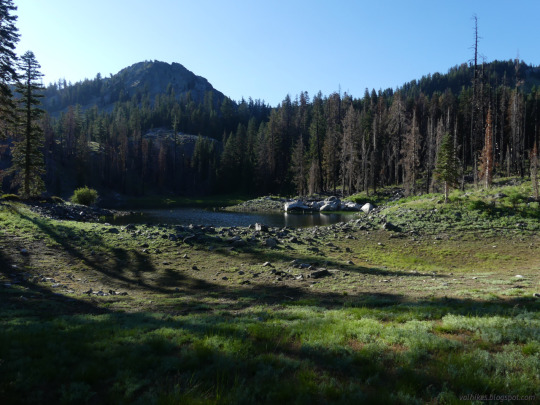




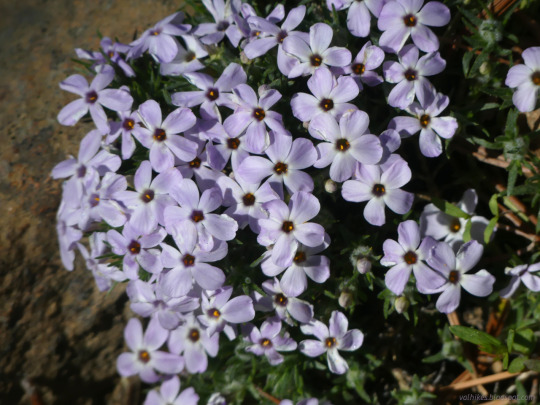
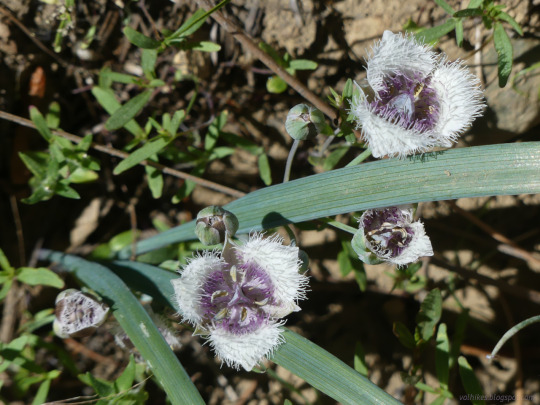



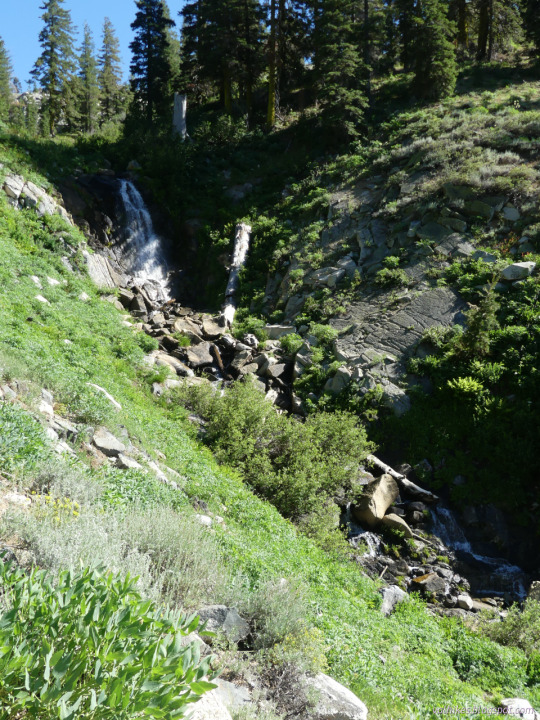

Klamath National Forest, California
The 4th day backpacking the Trinity Alps Wilderness did have some burn at the start, but mostly was a day of lakes and explorations. I stopped by one of the Forest's designated special places (for geology) even!
#hiking#nature#landscape#travel#hike#outside#mountains#California#Trinity Alps Wilderness#Klamath National Forest#KlamathNF#Siskiyou County#PNW#waterfall#lake#dam#frog#Boulder Lake#East Boulder Lake#Middle Boulder Lake#Lower Boulder Lake#Telephone Lake#Cement Banks#geology
3 notes
·
View notes
Text
moi: c'mon man we gotta focus
moi brain: 30, 40, 50, 100 years ago when these dams were first being built, their opponents were at their lowest. having a memory of what it was like before and what it was like after. what then was temporary became permanent in generational memory. do you think, then, that they could have ever anticipated that dam removal would come not by breaching or environmental disaster but voluntary removal. that in the devastation of the present we are often unknowingly living the rapturous dreams of those who came before us
3 notes
·
View notes
Link
2 notes
·
View notes
Text
i want to set the ents loose on silicon valley
#when the ents yell break the dam! i mean first hedgehachi dam then the klamath#i wish death on unregulated industry and greed!!!! death to all ceos and all company board members#personalig#lotr
2 notes
·
View notes
Text
The Klamath River is Free Flowing for the First Time in 100 years
Dams and hydropower are a key part of renewable energy in many parts of the world. But many rivers have seen major degradation of their environment due to rivers being dammed. Recently, the largest US dam removal project took place, allowing the 257-mile Klamath river in Oregon and norther California to flow freely.
The removal of four dams from the Klamath River, which spans parts of Oregon and…

View On WordPress
0 notes
Text


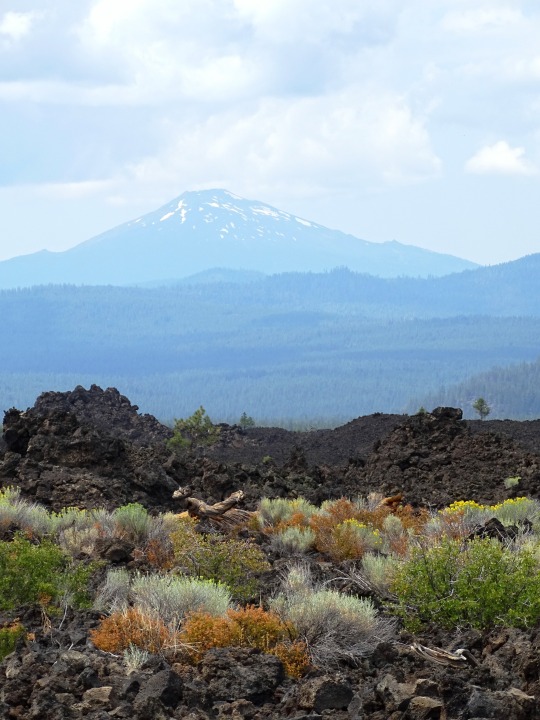

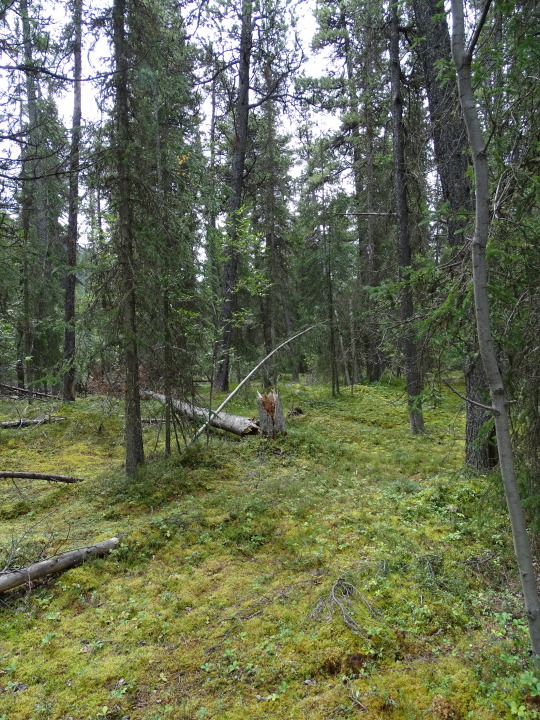









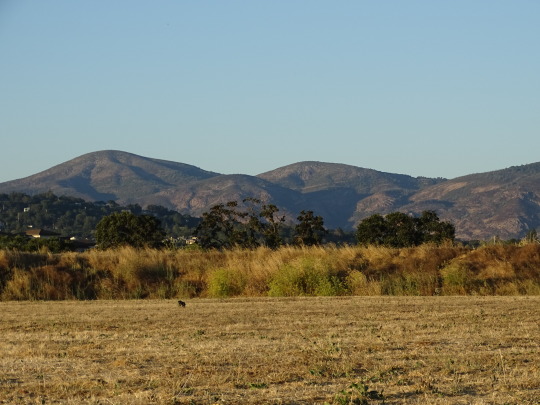
World Soil Day
One annual celebration people will be forgiven for not participating in (or even knowing about) is World Soil Day. Yes, soil—as in that sticky brown stuff that gets walked all over into prized cream carpets. Sadly, it is the ignorance about the importance of soil and the degree to which people take advantage of all that it offers that have led to a drastic reduction in its quality all over the world.
These are precisely the problems World Soil Day aims to battle, as few things could be more important to humans, the inhabitants of Planet Earth, who could never hope to survive without the land.
Soil is, without a doubt, one of the most significant parts of the ecosystem. Contributing to people’s food, water and energy and playing an important part in reducing the impact of climate change, soil is a vital part of life.
For all of these reasons, it’s high time that World Soil Day became known to more people than just scientists concerned about the welfare of our planet. So it’s time to get ready to learn about and celebrate this important day!
History of World Soil Day
In 2002, the International Union of Soil Sciences (IUSS) made a resolution proposing that the 5th of December be World Soil Day. The idea for the day was to make it possible to celebrate the importance of soil as a critical component of the natural system and as a vital contributor to human well-being.
Later, 2015 was also declared to be the International Year of Soils, in hopes of raising as much awareness as possible about the enormous role that soil plays in food security and, therefore, the very lifeline of humans. Unsurprisingly, so far it’s mostly been the global community of 60,000 or so soil scientists who have been the ones who are celebrating the day the most.
The chances of rather ordinary people exchanging ‘Happy Soil Day’ cards in the near future remain minimal. But that doesn’t mean that people can’t learn to appreciate the important role soil plays in human lives (even if it is darn hard to scrub off the carpet when those nearest and dearest feline friends leave muddy footprints on their way to the kitchen!).
Getting average people involved in becoming more aware of soil and taking part in its health is what this day is all about.
How to Celebrate World Soil Day
As it turns out, there are a number of things that average, regular people can do that can greatly help the soil they live off of to remain in good condition. It’s easy to get started with observing World Soil Day beginning with these ideas. Or for those who are super creative, they can come up with their own!
Get Educated About Soil
The best way to celebrate this day is to do exactly what scientists the world over so badly needs: to get educated. An enormous amount of damage is done to the planet every year–not due to ill will, but to ignorance. This is because many average people simply do not know enough about the earth to know when they are causing damage to it, sometimes damage that cannot be repaired.
Consider these resources for getting further educated on the issues related to World Soil Day:
Kiss the Ground (2020) This 90 minute documentary film featuring Woody Harrelson, Patricia Arquette and Tom Brady tells the important story of the soil being a viable solution to the world’s climate problems.
Symphony of the Soil (2012) Filmed on four different continents, this documentary features farmers, scientists, and ranchers who draw from ancient knowledge to pay respect to the importance of the soil.
The Biggest Little Farm (2018) Telling the story of one family’s attempt at farming, this documentary shows the way the little farm with depleted soil turned into a productive organic farm using regenerative agricultural practices.
Laguna Blanca (2012) Revealing how a farm in Argentina went from a single-crop, low-producing industrial farm to a multi-faceted area capable of production as well as lush greenery that houses many different wildlife.
Participate in a Soil-Friendly Activities
One of the first fun ideas average people can participate in is to plant a rain garden. For those who may not know what a rain garden is, it’s a shallow depression in the yard or garden that rainwater can easily flow into. This helps reduce soil erosion and promotes healthier soil.
Another important soil-friendly activity is composting. In order to stay rich in nutrients, soil needs access to fresh minerals which can come from dried leaves, dead plant parts, grass clippings and more. Keeping a compost heap in the backyard, filling it and turning it regularly not only improves the growing soil, but also reduces the amount of waste put into a landfill.
Read Kids Books about Soil
Got little family members, friends or school children who want to be educated on how important soil is to the lives of humans? Then try reading some different books with them about it! Here are a few to get started with:
The Magical World of Soil Biodiversity, by a variety of authors (2021).
You Wouldn’t Want to Live Without Dirt, by Ian Graham (2016).
The Good Garden: How One Family Went from Hunger to Having Enough, by Katie Smith Milway (2010).
What’s Sprouting in my Trash? A Book About Composing, by Esther Porter (2013).
Landscape and Plan for Less Erosion
It is a good idea to reduce to a minimum the amount of flat or paved surfaces on a property, such as driveways and patios. This is because the water flowing over these types of surfaces has a tendency to gain momentum which causes more erosion than it normally would once it reaches the soil.
For those who absolutely must have that patio, they should consider having it built with paving stones so rainwater can flow directly downward into the soil instead. It’s a much healthier (and prettier!) way to get that walking path in the garden.
Place a Rain Barrel
Another simple way to go about conserving soil (and in this case, water as well) is to have a rain barrel placed somewhere strategic where it can easily collect rainwater that is flowing off of the roof, which can then be used to water the grass and the plants.
Whatever you decide to do, remember that even the smallest gestures can make a big difference to Mother Nature!
Source
#Gitwangak Battle Hill#Whistler#Rancheria Falls Recreation Site#Whitehorse#Jasper National Park#Wells Dam#Napa Valley#Sonoma Valley#Klamath Falls#Yakima River Canyon#Columbia River Gorge#Newberry National Volcanic Monument#summer 2023#landscape#countryside#flora#geology#World Soil Day#WorldSoilDay#5 December#original photography#tourist attraction#landmark#travel#vacation#USA#Canada
0 notes
Text
how i wish to be a sentient tree breaking a dam and crushing orc & uruk-hai heads together
#this is an anti-dam blog#remove the klamath dam#(dams made by beavers are okay though)#m watches lotr
1 note
·
View note
Text

Headline by: Ryan Burns. “Ground Has Been Broken on Klamath River Restoration, the World’s Largest-Ever Dam-Removal Project.” Lost Coast Outpost. 23 March 2023.
---

The world’s largest dam removal in history is slated for 2023. Led by Indigenous tribes in partnership with organizations, lawyers, scientists and activists, the project will remove four dams, clearing the way for the lower Klamath River to flow freely for the first time in more than a century.
Headline and italicized text excerpt by: Malia Russ. “The Science of Saving Salmon as Klamath Dams Come Down.” UC Davis - Blogs - Climate. 24 February 2023.
---
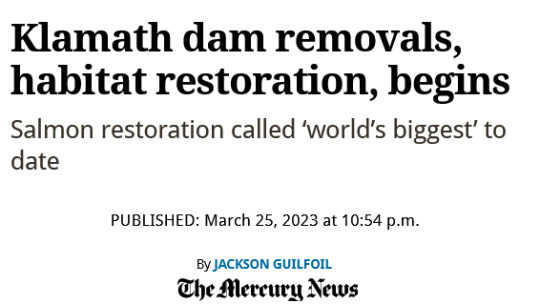
Headline by: Jackson Guilfoil. “Klamath dam removals, habitat restoration, begins.” The Mercury News. 25 March 2023.
---
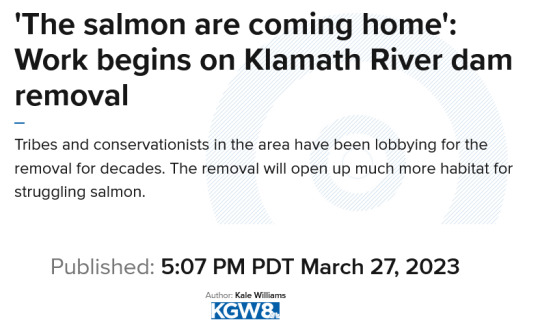
Headline by: Kale Williams. “‘The salmon are coming home’: Work begins on Klamath River dam removal.” KGW8. 27 March 2023.
---

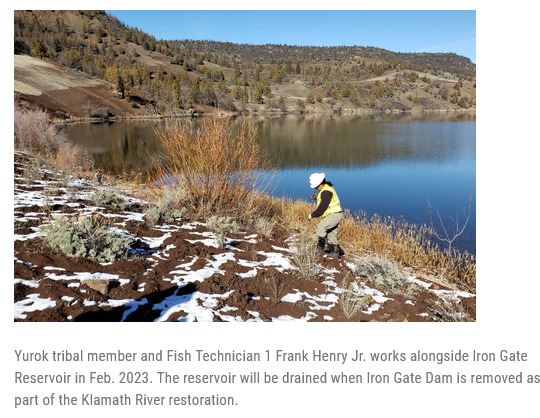
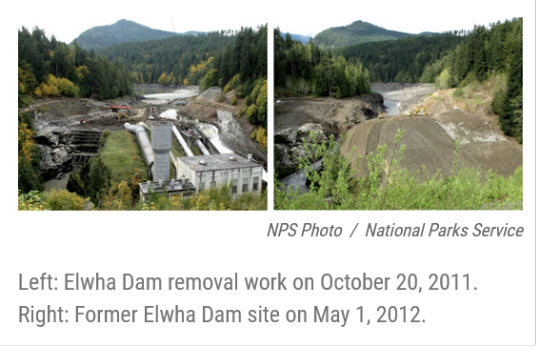
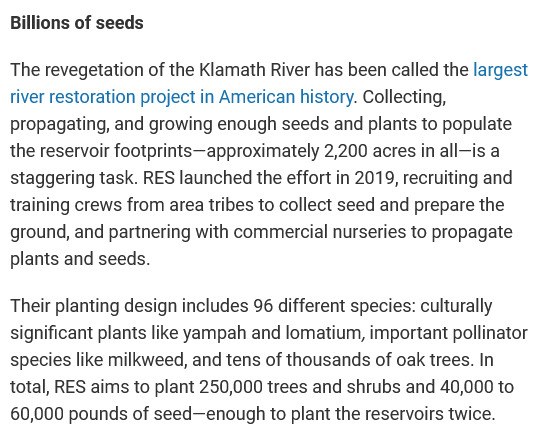
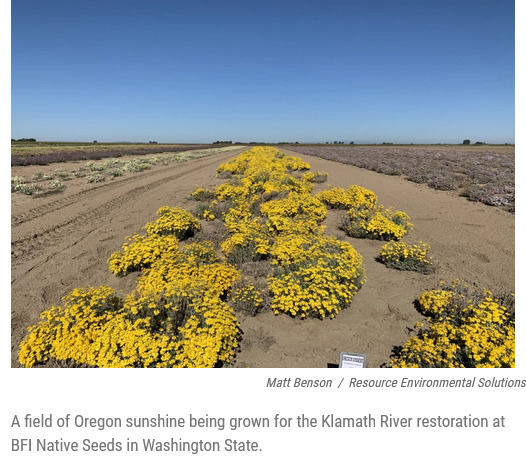
Iron Gate is a sinuous, skinny reservoir tucked into the folds of the Siskiyou Mountains. Draining it will expose about 900 acres of wet mud. “It’s our job to make sure it’s revegetated. We want that to be revegetated with a healthy native plant ecosystem,” says Joshua Chenoweth, Senior Riparian Ecologist for the Yurok Tribe who is leading the replanting effort. [...] Last fall, they seeded the strip with a mix of native grasses and flowering plants; now, they’re installing young shrubs and trees: buckbrush, serviceberry, and Oregon ash, along with the Klamath plum. Collectively, these plants will create a “wall of green,” taking up space that would have otherwise been overrun by non-native plants [...]. The revegetation of the Klamath River has been called the largest river restoration project in American history. Collecting, propagating, and growing enough seeds and plants to populate the reservoir footprints -- approximately 2,200 acres in all -- is a staggering task. [...] Their planting design includes 96 different species: culturally significant plants like yampah and lomatium, important pollinator species like milkweed, and tens of thousands of oak trees. [...] What will a restored, wild Klamath River look like? Imagine it. Stand at the Wanaka Springs boat launch and picture Iron Gate reservoir drained. The river has found its channel at the base of its original canyon. Willows flank the banks. Much of the reservoir footprint is flush with upland vegetation -- oak copses; thickets of buckbrush and Klamath plum; blooming rose and lupine.
---
Headline, images, captions, screenshot, and italicized text excerpt from: Juliet Grable. “After the dams: Restoring the Klamath River will take billions of native seeds.” Jefferson Public Radio. 13 March 2023.
2K notes
·
View notes
Text
There's been a recent increase in the removal of old dams and other barriers on salmon streams on the west coast of the U.S. While last year's removal of part a weir from McKay Creek wasn't as dramatic as the removal of dams on the Klamath River, the results of the removal are very promising.
The weir was installed about thirty years ago due to the creek being drained by a nearby reservoir. Unfortunately, its design meant that salmon could no longer go higher up the creek to their historic breeding grounds.
The power of nature's resiliency--if we give it the chance to recover--was evident in the fact that this past February saw the return of the salmon to the creek for the first time in three decades. What's even more exciting is that scientists found not just a few redds (salmon egg nests), but seventy-two of them in a six mile stretch of the creek above the weir! That's incredibly impressive, considering how long salmon were blocked from that area.
Here's to more projects like these giving our salmon a fighting chance for survival in spite of everything we've thrown at them over the years.
#salmon#fish#fishblr#icthyology#aquatic ecosystems#dams#dam removal#conservation#environment#environmentalism#habitat restoration#endangered species#extinction#wildlife#animals#nature#ecology\#restoration ecology
569 notes
·
View notes
Text
"The Yurok will be the first Tribal nation to co-manage land with the National Park Service under a historic memorandum of understanding signed on Tuesday [March 19, 2024] by the tribe, Redwood national and state parks, and the non-profit Save the Redwoods League, according to news reports.
The Yurok tribe has seen a wave of successes in recent years, successfully campaigning for the removal of a series of dams on the Klamath River, where salmon once ran up to their territory, and with the signing of a new memorandum of understanding, the Yurok are set to reclaim more of what was theirs.
Save the Redwoods League bought a property containing these remarkable trees in 2013, and began working with the tribe to restore it, planting 50,000 native plants in the process. The location was within lands the Yurok once owned but were taken during the Gold Rush period.
Centuries passed, and by the time it was purchased it had been used as a lumber operation for 50 years, and the nearby Prairie Creek where the Yurok once harvested salmon had been buried.
Currently located on the fringe of Redwoods National and State Parks which receive over 1 million visitors every year and is a UNESCO Natural Heritage Site, the property has been renamed ‘O Rew, a Yurok word for the area.
“Today we acknowledge and celebrate the opportunity to return Indigenous guardianship to ‘O Rew and reimagine how millions of visitors from around the world experience the redwoods,” said Sam Hodder, president and CEO of Save the Redwoods League.
Having restored Prarie Creek and filled it with chinook and coho salmon, red-legged frogs, northwestern salamanders, waterfowl, and other species, the tribe has said they will build a traditional village site to showcase their culture, including redwood-plank huts, a sweat house, and a museum to contain many of the tribal artifacts they’ve recovered from museum collections.
Believing the giant trees sacred, they only use fallen trees to build their lodges.
“As the original stewards of this land, we look forward to working together with the Redwood national and state parks to manage it,” said Rosie Clayburn, the tribe’s cultural resources director.
It will add an additional mile of trails to the park system, and connect them with popular redwood groves as well as new interactive exhibits.
“This is a first-of-its-kind arrangement, where Tribal land is co-stewarded with a national park as its gateway to millions of visitors. This action will deepen the relationship between Tribes and the National Park Service,” said Redwoods National Park Superintendent Steve Mietz, adding that it would “heal the land while healing the relationships among all the people who inhabit this magnificent forest.”"
-via Good News Network, March 25, 2024
#indigenous#land back#indigenous issues#first nations#native american#indigenous peoples#yurok#yurok tribe#national parks service#national park#redwoods#california#trees#trees and forests#united states#good news#hope#indigenous land
5K notes
·
View notes
Text
CA Redwoods to Be First National Park Co-Managed with a Native American Tribe That Used to Own it https://www.goodnewsnetwork.org/ca-redwoods-to-be-the-first-national-park-co-managed-with-a-native-american-tribe-that-used-to-own-it/
questionable headline aside this is good news
The Yurok will be the first Tribal nation to co-manage land with the National Park Service under a historic memorandum of understanding signed on Tuesday by the tribe, Redwood national and state parks, and the non-profit Save the Redwoods League, according to news reports.
The Yurok tribe has seen a wave of successes in recent years, successfully campaigning for the removal of a series of dams on the Klamath River, where salmon once ran up to their territory, and with the signing of a new memorandum of understanding, the Yurok are set to reclaim more of what was theirs.
#good news#environmentalism#science#canada#redwoods#yurok#save the redwoods league#not really land back#but still a good step#nature#stewardship#indigenous#indigenous land stewardship#environment#conservation#animals#trees#forests
3K notes
·
View notes
Note
This seems like good news
https://www.sfchronicle.com/bayarea/article/California-dam-removal-17187703.php?utm_campaign=CMS%20Sharing%20Tools%20(Premium)&utm_source=t.co&utm_medium=referral
Thanks for sharing this!
This project will remove four dams from the Klamath River and two from the Eel River.
Many of these dams were built before many modern requirements, such as fish passage, were in place. It was determined to be better for the local environment--and, in many cases, significantly cheaper--to demolish the dams rather than make the required modifications.
This joint project between corporations, government, and local tribes will be a boost to local fish populations and habitats that depend on these rivers.
Note: The article linked in the original ask was replaced with a different article covering the same story that is not behind a paywall.
#dam#fish conservation#dam removal#river conservation#indigenous conservation#good news#hope#habitat#biodiversity#conservation#submission#news#ask
460 notes
·
View notes
Text
"After 20 years of advocacy and legal challenges, the largest dam removal in history is returning the Klamath River in California to its natural state."
"In partnership with tribal nations, the demolition of four hydroelectric dams will allow wild salmon from the Pacific to run upstream and spawn again as they haven’t done for 100 years."
16 notes
·
View notes